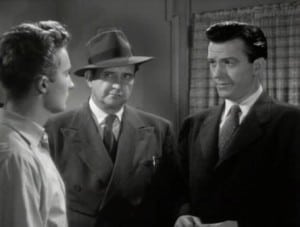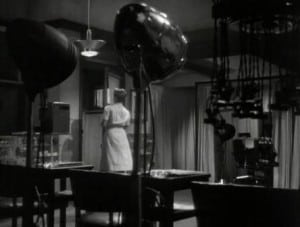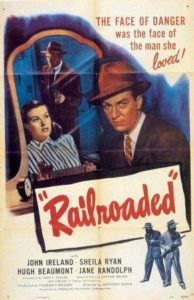“You know, they’re only two kinds of animals that make war on their own kind—rats and men, and men are supposed to be able to think.” — Police sergeant Ferguson to forensic expert “Doc”
Got a few hours to spare, seventy or so minutes, to be precise? Watching Railroaded!, best appreciated the first time, will prove an excellent window into what was to come—the careers of two individuals in particular. Director Anthony Mann had already made a tentative noise in film noir with such films as Strangers in the Night and The Great Flamarion. He perhaps would have hit his stride in the genre with He Walked by Night, except he directed only part of the film, and Alfred L.Werker, who did most of the work, received screen credit. In a rather different direction, Mann’s greatest fame began in 1950 with Winchester’73, the first of a half dozen Western collaborations with James Stewart that proved the versatility of both men.
John Ireland, who had top billing in Railroaded!, made, as his future would prove, a deceptively positive impression in his first picture, A Walk in the Sun. His role as a sympathetic, intelligent GI would not be the typical role he would most often play, that of the heavy. His career in Hollywood would peak rather early—most famously in Howard Hawk’s Red River (1948) and a year later in All the King’s Men, for which he received his only Oscar nomination. His defining role in Railroaded! as a hard, almost charming killer would be one of his best.
He entered television as early as 1950, and, more and more, his career was so concentrated, with guest appearances in most of the current series, especially Westerns—Bonanza, Gunsmoke, Zane Grey Theater, Rawhide and Branded.
 Railroaded! Not every movie title includes an exclamation point. Personally, the musical Oklahoma! comes immediately to mind, but there are other such titles, losers like Berserk!, the Joan Crawford gore fest, and Die, Monster, Die!, Boris Karloff as a recluse who acquires power from a meteor; another musical, Oliver!; and the dark I Want to Live!, Susan Hayward’s harrowing date with the gas chamber.
Railroaded! Not every movie title includes an exclamation point. Personally, the musical Oklahoma! comes immediately to mind, but there are other such titles, losers like Berserk!, the Joan Crawford gore fest, and Die, Monster, Die!, Boris Karloff as a recluse who acquires power from a meteor; another musical, Oliver!; and the dark I Want to Live!, Susan Hayward’s harrowing date with the gas chamber.
The product of the small Producers Releasing Corporation, Railroaded! is a sure-enough low-budget film as to the money invested and the brief filming schedule, but thanks to generally good acting, the tight script by John C. Higgins, the art direction of Perry Smith and the cinematography of Guy Roe, what’s up on the screen can almost pass for a Warner Brothers or RKO production.
 In the manner of a Michael Curtiz trademark, Roe likes to photograph different perspectives with objects in the foreground. When what would now be called the forensic expert (the uncredited “criminologist,” Mack Williams) confides evidence to the police sergeant (Hugh Beaumont), the two men stand behind various objections, brightly lit in an otherwise dark room, much as another lamp is forward on a desk in the killing of the nightclub owner (Roy Gordon). In the opening scene in the beauty parlor, there are four shop hair dryers which take forward prominence, almost like characters in the drama.
In the manner of a Michael Curtiz trademark, Roe likes to photograph different perspectives with objects in the foreground. When what would now be called the forensic expert (the uncredited “criminologist,” Mack Williams) confides evidence to the police sergeant (Hugh Beaumont), the two men stand behind various objections, brightly lit in an otherwise dark room, much as another lamp is forward on a desk in the killing of the nightclub owner (Roy Gordon). In the opening scene in the beauty parlor, there are four shop hair dryers which take forward prominence, almost like characters in the drama.
Roe’s camera is equally effective when it is panning, dollying or zooming, yet when stationary and the actors move both in the foreground and in the background, the screen holds interest.
The main title sets the mood rather well, if typical in this genre, with a night scene of the Big City, a wide, lighted street disappearing into the distance. Black and white, of course. The musical score, which here already includes a piano, is by Alvin Levin, whose work was confined to five films in 1947, of which Railroaded! is the best known. At one point, when the requisite femme fatale slinks back to her apartment after making a phone call to the police—information in exchange for protection—the music is appropriately creepy and mysterious; at other times, Levin is too intrusive, more dramatic or emphatic than certain scenes require. For the most part, the score seems a timid participant in things, though the film is strongly sufficient on its own.
